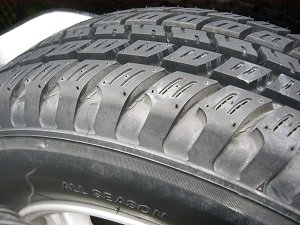So your closet has a pair of flip-flops for the summer, a pair of heavy boots for the winter, and a comfortable pair of sneakers for most of the rest of the year. If you live in a climate that doesn’t have harsh winters, you might just be able to wear those sneakers year-round…and all-season tires are the equivalent of your comfortable sneakers.
So what makes all-season tires so special?
Winter tires are excellent for severe conditions like heavy snow and even ice. They feature specially-designed tread patterns and “sipes”, hundreds of tiny slits which offer biting edges for traction in snow. This means shorter stopping distances, better handling and better control in winter weather. Winter tires are not d
esigned for temperatures above 40 degrees Fahrenheit. The downside of winter tires is they use a tread formulation which stays softer in cold weather…but that means the rubber will also wear much faster in warmer conditions. In addition, winter tires, while a far cry from the “snow tires” or “mud grips” which might have been on your dad’s station wagon, tend to be noisier and have clumsier handling on dry pavement.
Summer tires are designed with shallower tread depth and more aggressive tread patterns for excellent steering response, handling and performance on wet or dry pavement. They also use a soft tread formulation for extra “stickiness” and traction in hot weather. The combination of tread design and rubber compound adds up to a tire with outstanding cornering ability for spirited driving. Unfortunately, that same sticky tread formulation stiffens up at temperatures below 40 degrees, resulting in lousy traction on snow or wet pavement. All-season tires, attempt to offer the best of all possible worlds. This means a moderate tread depth which splits the difference between summer and winter tires, with a pattern of sipes and extra gripping edges for extra traction in wintry conditions. Typically, all-season tires might be designed with circumferential grooves at the center for straight-line stability, and a groove pattern that evacuates water from the tire’s footprint to help prevent hydroplaning on wet pavement.
Engineers design all-season tires with a computer-tuned tread and rubber compound to keep road noise low and provide a supple, forgiving ride on most pavement types. It’s this combination of qualities which make all-season tires an excellent choice for most drivers, and it’s why most sedans, minivans and SUVs come from the factory with all-season tires as original factory equipment. For most drivers, in most parts of the country, all-season tires truly are the equivalent of those sneakers you can wear year-round!


